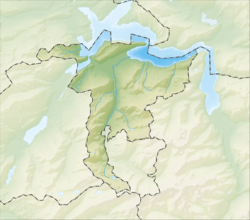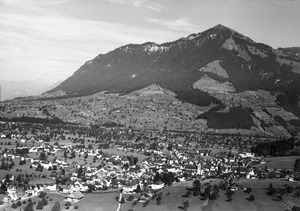Oberdorf, Nidwalden facts for kids
Quick facts for kids
Oberdorf
|
||
|---|---|---|
 |
||
|
||
| Country | Switzerland | |
| Canton | Nidwalden | |
| District | n.a. | |
| Area | ||
| • Total | 16.2 km2 (6.3 sq mi) | |
| Elevation | 455 m (1,493 ft) | |
| Population
(Dec 2020 )
|
||
| • Total | 3,080 | |
| • Density | 190.1/km2 (492.4/sq mi) | |
| Postal code |
6370
|
|
| Surrounded by | Beckenried, Buochs, Dallenwil, Stans, Wolfenschiessen | |
Oberdorf is a small town, also called a municipality, in the canton of Nidwalden, Switzerland. It's made up of several smaller villages and hamlets. These include Wil, Ennerberg, Waltersberg, Büren nid dem Bach, and Niederrickenbach.
A special place in Oberdorf is the Maria-Rickenbach convent. This is a Benedictine convent located near the hamlet of Niederrickenbach. It sits high up at 1,150 meters (about 3,773 feet) and you can reach it by a cable car!
Contents
A Look at Oberdorf's History
Oberdorf has a long history! The town was first mentioned in official records way back in 1199. Back then, it was called Obirndorf. Later, in 1275, its name changed slightly to Oberndorf.
Exploring Oberdorf's Geography
Oberdorf covers an area of about 16.2 square kilometers (about 6.25 square miles). A big part of this land, about 53%, is used for farming. Forests cover another large portion, about 38.3%. The rest of the land is used for buildings and roads (6.7%), or it's made up of natural features like rivers and mountains (1.9%).
The municipality is located near and above the town of Stans. Oberdorf gets its name, which means "Upper village" in German, because its main parts are located higher up than Stans. These "upper villages" include Wil, Ennerberg, and Waltersberg. The hamlets of Büren (nid dem Bach) and Niederrickenbach are also part of Oberdorf.
Who Lives in Oberdorf?
Oberdorf has a population of about 3,123 people (as of 2008). Over the last ten years, the number of people living here has grown by about 7.6%.
Most people in Oberdorf speak German, about 95.2% of the population. Other languages spoken include Albanian (0.8%) and English (0.7%).
In 2008, the population was almost evenly split between males (50.3%) and females (49.7%). Many adults in Oberdorf, about 70.6%, have completed higher education. This means they have gone to a special school after high school, like a university.
Oberdorf has a very low unemployment rate, which means most people who want to work have jobs. About 214 people work in farming, and 530 people work in manufacturing or construction. Another 252 people work in service jobs, like shops or hotels.
Here's how Oberdorf's population has changed over the years:
| Year | Population |
|---|---|
| 1850 | 971 |
| 1900 | 1,117 |
| 1950 | 1,455 |
| 1960 | 1,501 |
| 1970 | 1,783 |
| 1980 | 2,272 |
| 1990 | 2,663 |
| 2000 | 2,992 |
| 2005 | 2,961 |
| 2008 | 3,123 |
What to See in Oberdorf
The main attraction in Oberdorf is the pilgrimage chapel called Niederrickenbach. It's a special place that many people visit.
See also
 In Spanish: Oberdorf (Nidwalden) para niños
In Spanish: Oberdorf (Nidwalden) para niños





